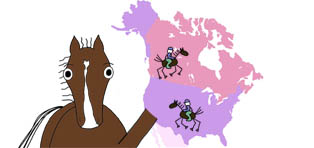
By Staci Matlock | The New Mexican
September 3, 2007
Horses, riders get first taste of toughness on first 50-mile leg of race
Trotting out on a long-legged quarter horse named Nugget and wearing a black felt cowboy hat with cut-off jeans, Dawson Higgins didn’t look like a typical endurance rider.
But the Tucumcari resident was the quintessential picture of cowboy New Mexico as he rode the first leg of the 515-mile, 15-day Great Santa Fe Trail Horse Race. The race ends Sept. 15 in Independence, Mo.
“I took my (coiled) rope off before we started,” Higgins, 27, said with a smile, taking a break during the ride. “Otherwise, they really would have laughed at me.”
A total of 40 riders began the ride from Country Road 51 at Glorieta/Rowe Mesa about 7:30 a.m. Monday. The ride finished for the day almost 50 miles later near Ribera.
The first two riders to finish the day rode Arabians equipped with light-weight endurance saddles, similar to English saddles, carrying water bottles and other gear typical of endurance riders. First in was Scott Griffin of Seattle, on Cruiser, followed closely by Tennessee Lane Mahoney, a newlywed and horse-trainer from Windsor, Colo., on Sabella. Both riders intend to ride their horses the entire distance.
Dawson held his own, coming in third. His teammate, Shawn Davis, 39, will ride the 50 miles to Springer today. The Tucumcari duo are the only all-New Mexico team in the race.
The first day was likely the toughest of the two-week event, according to riders and race organizers. Veterinarians checked horses before the race began, at two stops during the day’s ride and at the end. Any horse whose heart rate didn’t reach 60 beats per minute within 10 minutes or who showed signs of dehydration or injury were pulled from the race. Similar vet checks will occur each day of the event under rules set by the American Endurance Racing Conference.
Jean Albert Renaud, a Motown songwriter and horseman from Maryland who goes by the name JAR, had to pull out his black stallion Tody at the first stop. The stallion, a Morgan, Arabian and Tennessee Walker crossbreed, stepped on sharp shale and ended up with the horse version of a swollen ankle. “The main thing is to get these horses through safely,” said Renaud, 65, who will ride today with his son on two more of their “Morwalkarabs.”
The first leg Monday covered 14 miles and went up the mesa along a power-line road and over to N.M. 34 on top of the mesa. The next leg was 28 miles across the mesa and down “one long rock” as a rider described it, before reaching the second stop near Ribera. The last leg of the day’s race was a short six-mile hop across the Pecos River. Riders and horses were picked up there by their crews and driven in to Las Vegas, N.M., where they will stay at the mobile Race Village.
Riders with many levels of experience in all kinds of gear and riding several different breeds of horses began the first day of the inaugural event.
Mac McSwain, a cowboy out of Winona, Texas, intends to ride the whole distance switching off between six Spanish mustangs. He wanted to do the race “so the world can see these are great little horses,” McSwain said.
He had a newly purchased equine heart monitor and a global positioning system unit, but “I don’t know how to use either one,” he said with a laugh as he waited his turn for a vet check.
Jonathan Jordan, a rider from Alpine, Calif., wore running shoes. "I like to run," said Jordan, an experienced endurance rider. "It gives tHe horse a break. I ride about 10 miles and then get off and run about two miles."
Paul Strick of Pierce City, Mo., at 69 is the oldest rider in the event. He’s riding two Arabian/quarter-horse brothers and will attempt the entire distance at a leisurely pace. “Some of these riders will go 9 to 10 mph. I’ll go about 4. I want to go home with these horses healthy. If I don’t, my wife is liable to divorce me or kill me."
A cadre of volunteers, also from across the country, are helping check horses in, haul water to rubber tanks placed every five or six miles and try to keep the chaotic event running smoothly.
Minnesotan Craig Opel volunteered for another reason. Along the way, he’s dropping by points along the historic Santa Fe Trail where his great-great-great-uncle and aunt stopped in 1850 as they came across by wagon train. His ancestor Anna Maria Morris kept a diary of the trip, and it was published in the book, Cover Wagon Women - Diaries and Letters from the Western Trails. "I came on this to find as many spots where they stopped as I can," Opel said.
He took a brief detour during the race to the crumbling adobe church at the Pecos National Historic Park. "I stood exactly where she stood 157 years and 15 days ago,” Opel said. "It was pretty cool."
Contact Staci Matlock at 470-9843 or smatlock@sfnewmexican.com.
Following the race
Sept. 2 — Santa Fe
Sept. 3 — Las Vegas, N.M.
Sept. 4 — Springer
Sept. 5 — Clayton
Sept. 6-7 — Elkhart, Kan.
Sept. 8 — Dodge City, Kan.
Sept. 9 — Larned, Kan.
Sept. 10 — Lyons, Kan.
Sept. 11-12 — Council Grove, Kan.
Sept. 13 — Burlingame, Kan.
Sept. 14 — Gardner, Kan.
Sept. 15 — Independence, Mo.
For more information on the race, visit www.sfthorserace.com.

1 comment:
more photos of other riders posted please! I have friends on this ride and would love to see other shots, not just the hot shoes.
Post a Comment